A.L. Bracht House
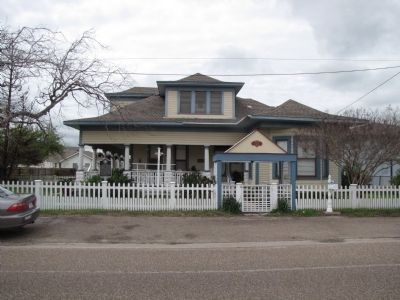
409 N. Magnolia, Rockport, TX 78382 (see map) Adolph Bracht (1872-1961) was born in Rockport and worked at lumber and grocery stores before establishing his own wholesale and retail grocery in 1899. He was a charter member of the Intracoastal Canal Association and active in the Chamber of Commerce and Sacred Heart Catholic church for many years. He shipped vegetables raised by growers in this area and the Rio Grande Valley. He ran his grocery business until his retirement in 1947. Adolph and his wife Gertrude (Prophet) had nine children. Their prairie-style two-story house (Built c.1898-1902) features lap siding, a low-pitched roof with dormers, wraparound porch with Doric columns and cast stone footings and an asymmetrical facade with bay windows.
St. Peter’s Episcopal Church
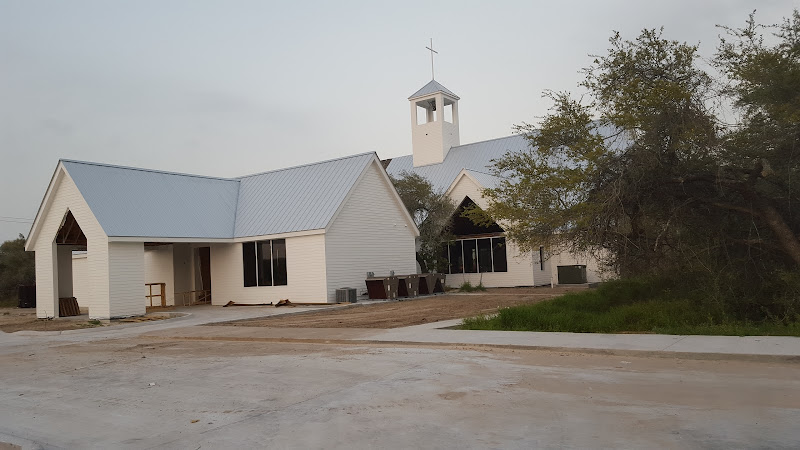
412 N. Live Oak Street, Rockport, TX 78382 (see map) MARKER TEXT The Rt. Rev. Alexander Gregg, Bishop of the Diocese of Texas, officiated at the dedication of St. Peter’s Episcopal Church in Rockport on November 30, 1871. Led by lay ministers for much of its early history, St. Peter’s first was located at the corner of Live Oak and Wharf Streets near the railroad depot, where services often were halted due to the noise of arriving and departing trains. Relocated to this site in 1954, St. Peter’s became a self-sustaining parish ten years later. It continues to serve the community with a variety of programs. (1991) State Historical Marker Number: 5078
Aransas County

301 N. Live Oak, Rockport, TX 78382 (see map) Created out of the coastal portion of Refugio County in 1871, Aransas County is the second smallest county in Texas. Within its boundaries are three bays of the Gulf of Mexico – Copano, St. Charles, and Aransas. The area was the site of early Indian inhabitation and Spanish exploration, as well as Anglo colonization efforts of the 1830s and 1840s. Aransas County communities are supported by such industries as fishing, agriculture, offshore oil production, bird watching, and tourism. The county is home to the Aransas National Wildlife Refuge, created in 1937. (1990)
L.M. Bracht House
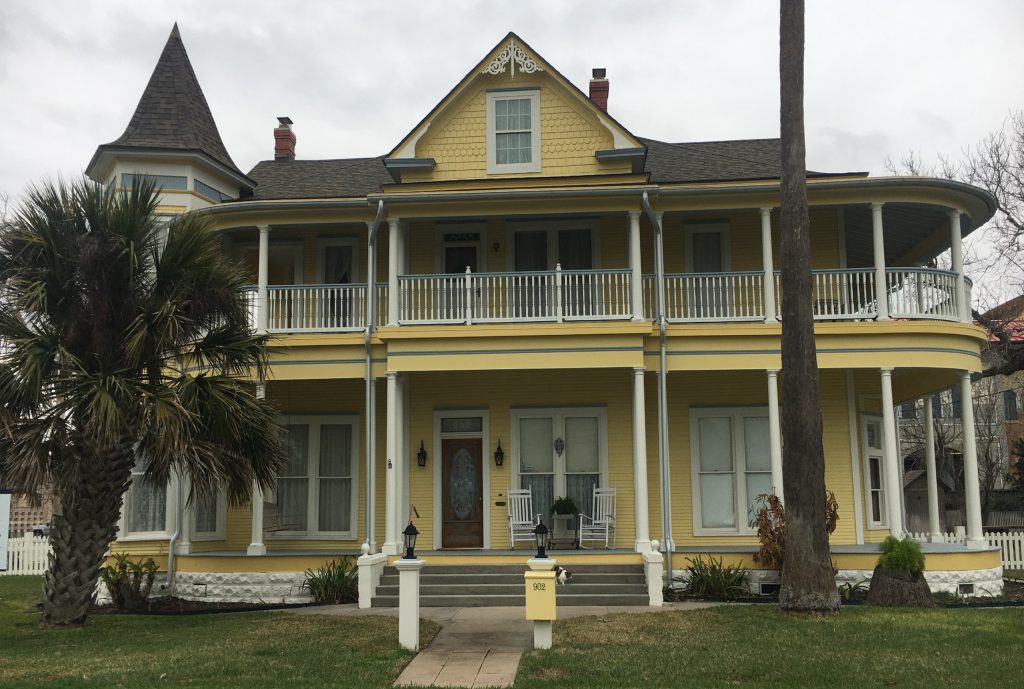
902 E Cornwall St, Rockport, Tx 78382 (see map) The L.M. Bracht home was built in Oklahoma in 1881 by F.C. Finney, the developer. The Brachts moved the home here in 1889. The home received a National Register of Historic Places designation in January 2023 and is pending the physical receipt of its Texas State marker.
Richard Henry Wood House
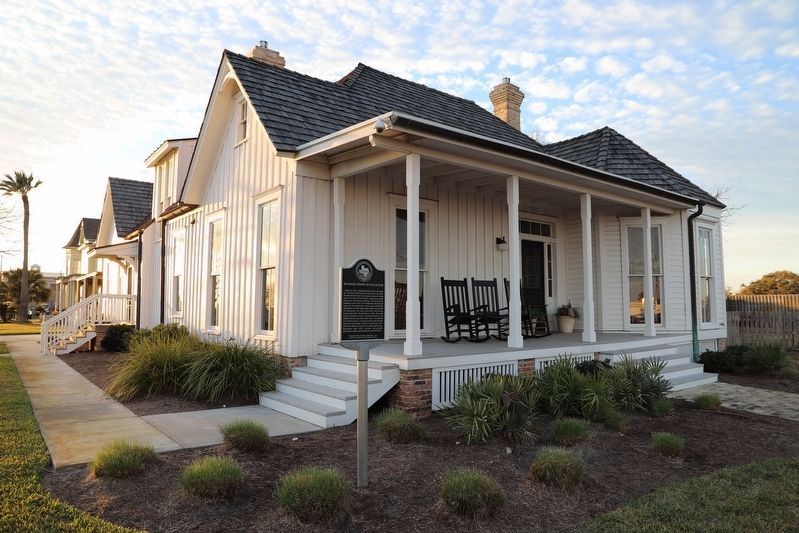
203 N. Magnolia St., Rockport, Tx 78382 (see map) MARKER TEXT Born in 1846, Richard Henry Wood was one of the first residents of Rockport. In 1866, Wood partnered with James Doughty and built the first cattle pens, warehouse and wharf at Rockport Harbor. Wood ran his business until the 1919 hurricane destroyed many of his holdings. Wood was appointed Alderman in 1870 and later served as Mayor of Rockport. He also initiated the Texas Game and Fish Commission in 1907. The 1868 house exhibits many characteristics of Greek Revival architecture style, including its white color, columns and wide board and batten siding. Until his death in 1923, Richard Wood’s roles as a land developer, rancher and civic leader influenced Rockport’s early development and growth The Wood House Early records show Richard Henry Wood was owner of this home in 1868. He was the third child, first son of John Howland Wood, one of the founders of Rockport. Richard H. Wood served in the Civil War with Company B, 29th Brigade Texas Militia for Refugio County (also known as Captain Daniel C. Doughty’s Spy Company) , was active in the Aransas Pass Land Company, handled the sales promotions in connection with the area’s land booms from 1890 to the turn of the century, was mayor or Rockport and the first commissioner over wildlife laws, appointed by Gov. Thomas M. Campbell in 1907. Richard H. Wood and Samuel B. Allyn, formed a partnership and acquired all of St. Joseph Island. This cattle partnership and ownership of St. Joseph Island lasted until 1915 at which time he and his son, Will Welder Wood, became the sole owners of the island. St. Joseph’s Island was sold by the Wood family in 1922 to Cyrus B. Lucas.
Site of Aransas Hotel in Rockport
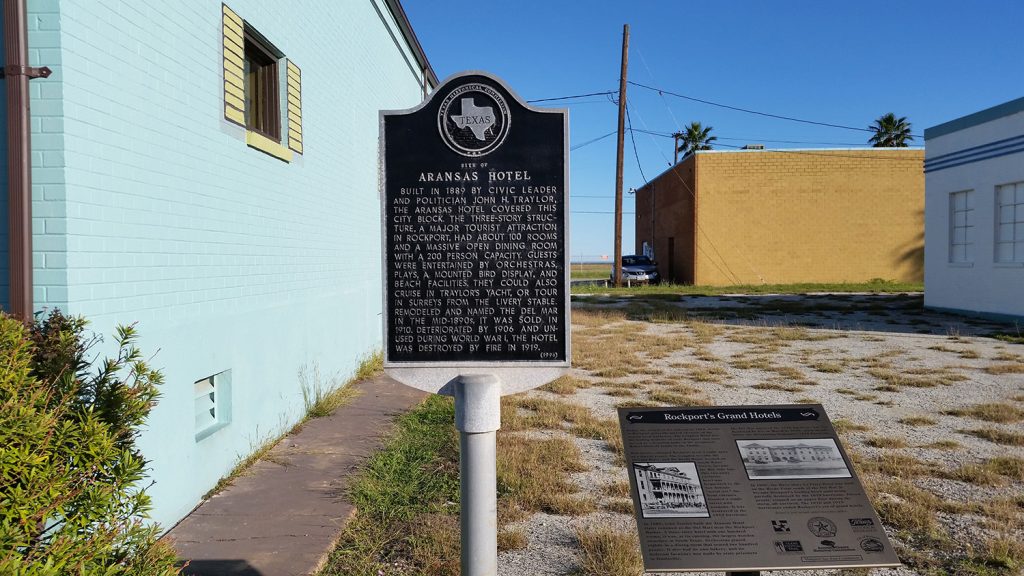
Austin and Main St.,Rockport, TX 78382 (see map) MARKER TEXT Built in 1889 by civic leader and politician John H. Traylor, the Aransas Hotel covered this city block. The three-story structure, a major tourist attraction in Rockport, had about 100 rooms and a massive open dining room with a 200 person capacity. Guests were entertained by orchestras, plays, a mounted bird display, and beach facilities. They could also cruise in Traylor’s yacht, or tour in surreys from the livery stable. Remodeled and named the Del Mar in the mid-1890s, it was sold in 1910. Deteriorated by 1906 and unused during World War I, the hotel was destroyed by fire in 1919. (1996)
Rockport Wharves and Pavilions
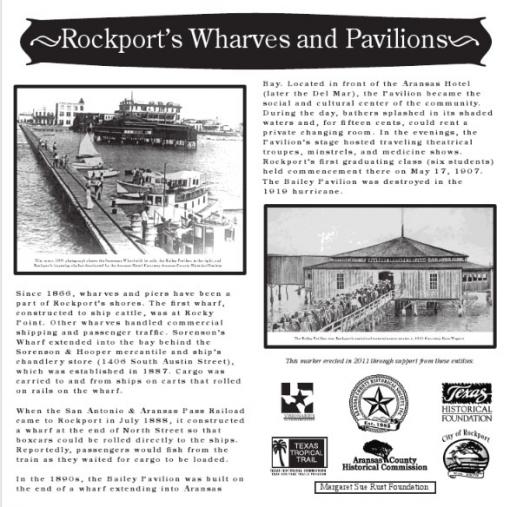
Since 1866, wharves and piers have been a part of Rockport’s shores. The first wharf was at Rocky Point, constructed to ship cattle. Other wharves handled commercial shipping and passenger traffic. Sorenson’s Wharf extended into the bay behind the Sorenson & Hooper mercantile and ship’s chandlery store (406 South Austin Street), which was established in 1887. When the San Antonio & Aransas Pass Railroad came to Rockport in July 1888, it constructed a wharf at the end of North Street so that boxcars could be rolled directly to the ships. In the 1890s, the Bailey Pavilion was built on the end of a wharf extending into Aransas Bay in front of the Aransas Hotel (later the Del Mar) and became the social and cultural center of the community. Rockport’s first graduating class (six students) held commencement there on May 17, 1907. The Bailey Pavilion was destroyed in the 1919 hurricane.
The Packeries of Rockport
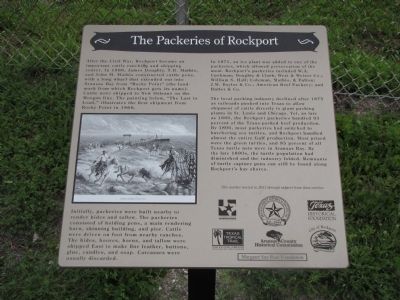
In 1866, James Doughty, T.H. Mathis, and John M. Mathis constructed cattle pens, with a long wharf that extended out into Aransas Bay from “Rocky Point” (the landmark from which Rockport gets its name). Cattle were shipped to New Orleans on the Morgan line. The hides, hooves, horns, and tallow were shipped East to make fine leather, buttons, glue, candles, and soap. Carcasses were usually discarded. In 1871, an ice plant was added to one of the packeries, which allowed preservation of the meat. As late as 1880, the Rockport packeries handled 93 percent of the Texas-packed beef production. By 1890, most packeries had switched to butchering sea turtles, and Rockport handled almost the entire Gulf production. By the late 1890s, the turtle population had diminished and the industry folded. Remnants of turtle capture pens can still be found along Rockport’s bay shores.
Rockport Harbor
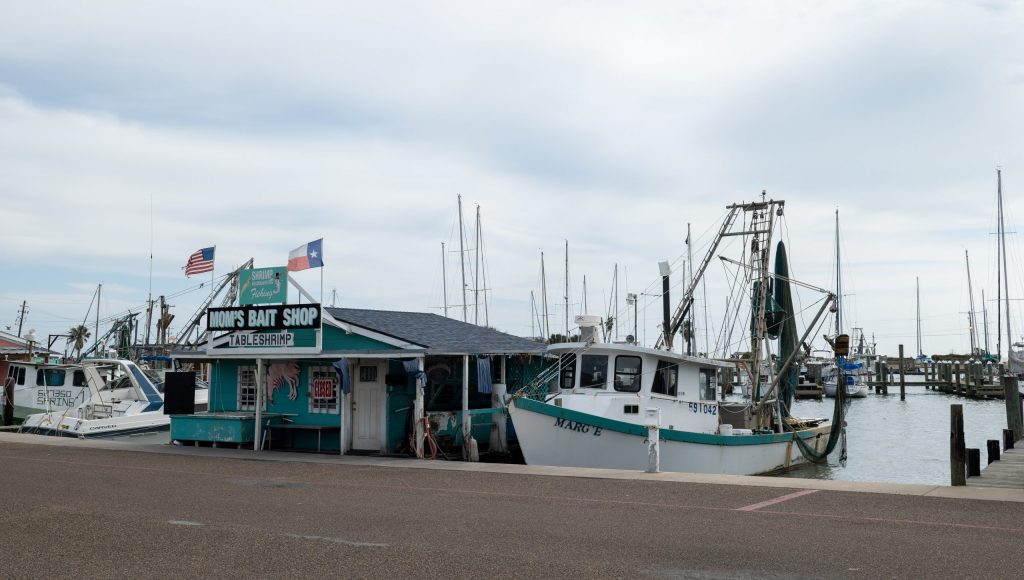
28°01’29.9″N 97°02’51.2″W Navigation Cir, Rockport, TX 78382 (see map) In 1866, James Doughty and Richard H. Wood, searching for a safe harbor location to ship cattle, built pens and a livestock-shipping wharf on “Rocky Point”. Other wharves and pens followed. Soon, a regular schedule of Morgan line shallow-draft steamboats arrived with merchandise and departed with cattle and packery products. In 1888, the railroad ignited a boom in Rockport, prompting local businessmen to begin advertising a strategic harbor near the Gulf. They also pushed to deepen it and create a deep-water port, but the effort ended when Corpus Christi opened its port in 1926. However, abundant harvests of fish, oysters, and shrimp fueled a thriving seafood industry. By 1910, fish houses anchored the southwest side of the Rockport Harbor and numerous fishing boats moored at harbor wharves. By 1940, a new breakwater and a concrete piling and steel seawall created a small-craft safety basin which became Rockport’s famous “fish bowl” harbor.
Rockport’s Seafood Industry

28°01’28.3″N 97°03’01.5″W 198 TX-70 Loop, Rockport, TX (see map) Rockport’s commercial seafood companies have been operating for more than one hundred years. By 1903, David Rockport Scrivner had opened a fish house. In 1907, it sold and became the Jackson Fish Company. A few years later, it sold again and began the Union Fish Company. The 1919 hurricane destroyed the Union Fish building, but it was rebuilt, and, in 1932, the building became a ship’s chandlery. About 1909, the Rockport Fish and Oyster Company was established. In 1919, Ford Jackson bought his brother’s interest in the Jackson Fish Company and changed the name to Jackson Seafood Company. Jackson added shrimp to his harvest, and the local shrimping industry developed rapidly after 1925. By 1935, the Johnson Fish Company was established; shrimp was its main product. After Hurricane Celia in 1970, Jackson Seafood diversified by harvesting sea scallops on the East Coast. Although the company closed in 1991, several other Rockport firms have continued harvesting fish and shrimp.

